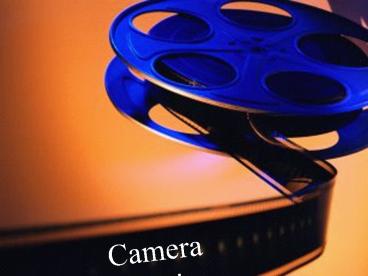Camera Framing PowerPoint PPT Presentation
1 / 34
Title: Camera Framing
1
Camera Framing
2
Field of View Reaction shot Extreme long shot
One shot Long shot Two shot Medium Shot
Three Shot Extreme Close-up Close-up
Over-the-Shoulder shot
3
Traditional Film Camera TechniquesIn film and
video production the cinematographer sets the
camera shots frames images and decides what
camera movement is necessary for a scene. But
more importantly the framing and what is in the
frame at any given moment. Framing consists of
the image within the rectangular image of the
Motion Picture.
4
The Field of View (FOV) is the angle described by
a cone with the vertex at the camera's position.
It is determined by the camera's focal length,
with the shorter the focal length the wider the
FOV. For example, for a 35mm lens the FOV is 63
degrees (wide-angle), for a 50 mm lens it is 46
degrees (normal), and for a 135 mm lens it is 18
degrees (telephoto). A wide angle lens
exaggerates depth while a telephoto lens
minimizes depth differences.
5
Shot Visual Composition Use
- Extreme long shot
- Very long shot/wide shot
Characters are small in frame all or major parts
of buildings appear
Most often used for Establishing shots that set
the physical context of action shows landscape
and architectural structures.
6
(No Transcript)
7
Shot Visual Composition Use
- Long shot
All or nearly all of the standing person large
parts of a building
Shows a large scale action shows whole groups of
people displays large architectural details
8
(No Transcript)
9
(No Transcript)
10
Shot Visual Composition Use
- Medium shot
Character shown from waist up medium-sized
architectural details
Small groups such as two or three people
11
(No Transcript)
12
(No Transcript)
13
Shot Visual Composition Use
- Close-up
Head and neck of character objects about the
size of the desktop computer fill frame
focus on one character facial expression very
important
14
(No Transcript)
15
(No Transcript)
16
Shot Visual Composition Use
- Extreme close-up
The frame filled with just part of a character or
very small objects
Facial features in a character or small objects
17
(No Transcript)
18
(No Transcript)
19
Reaction ShotA shot showing a characters
expression as they react to something
20
(No Transcript)
21
Over-the-shoulder shot A shot in which we see a
character over anothers shoulder, often used in
interviews or dialogues
22
(No Transcript)
23
(No Transcript)
24
Screen Composition
25
One Shot
A screen shot the consists of one actor. A
"One-Shot" may be a mid-shot or medium shot or a
close-up of a single person .
26
Two shot
A screen shot the consists of two actors.
Generally, the actors face one another in
profile. There are a few variations on this one,
but the basic idea is to have a comfortable shot
of two people. Often used in interviews, or when
two presenters are hosting a show.
27
Two shot
28
(No Transcript)
29
Three Shot
Screen Composition
- A screen shot the consists of a group of three
actors.
30
Three Shot
31
(No Transcript)
32
Dutch angle, oblique angle, canted angle, are
terms used for a cinematic tactic often used to
portray the psychological uneasiness or tension
in the subject being filmed. A Dutch angle is
achieved by tilting the camera off to the side so
that the shot is composed with the horizon at an
angle to the bottom of the frame. The angle was
widely used to depict madness, unrest, and
disorientation in German Expressionism.
33
- The 1949 film The Third Man makes extensive use
of Dutch angle shots, to emphasize the main
character's alienation in a foreign environment.
34
The End

